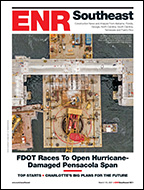
Emergency repairs are getting under way on thirty-two steel-threaded connecting rods on the $6.4-billion San Francisco-Oakland Bay Bridge’s 10,176-ft.-long eastern span, after California Dept. of Transportation officials revealed the rods snapped after being tensioned. The 525-ft-tall self-anchored suspension (SAS) structure is still expected to open on Labor Day weekend, as scheduled, carrying 280,000 vehicles daily over two stacked 5-lane roadways. American Bridge-Fluor Enterprises is the joint-venture general contractor, with T.Y. Lin International, San Francisco, and Moffatt & Nichol, Long Beach, Calif., as bridge designers.
The broken rods are not considered a structural problem, nor are they expected to delay the opening, says Randy Rentschler, a spokesman with the Metropolitan Transportation Commission, the regional agency which manages the Caltrans-owned bridge.
At least 32 rods, or bolts, attached to earthquake safety devices called shear keys, are being replaced. The 3-in-dia rods, which are 9 ft to 24 ft long, attach to 6-ft-tall by 9-ft-wide steel shear keys, which allow controlled lateral bridge movement during a seismic event. The rods are located in the gap between the easternmost pier of the 2,047-ft SAS span and the 35,200-ton overhead road deck. Rods are fastened in place by threaded hex nuts.
Repairs could prove tricky since the rods are encased in a concrete cap beam atop two piers rising out of the water. As such, many cannot be easily removed by a hydraulic jack. Caltrans could consequently use a stabilizing collar attachment around the base as an alternate solution, the agency said. While it’s too early yet to determine repair costs, state officials blame a hydrogen-contaminated steel manufacturing process for brittleness that led to cracks and breaks.
“Given the significant number of the failure of the bolts, I think there clearly was a quality-control failure,” said MTC executive director Steve Heminger in a statement.
There are a total of 288 concrete encased rods; nearly one-hundred rods were tensioned and inspected, one-third of which need replacing. The bolts were installed in 2008, but crews have just started tightening them. The remaining bolts, located further below the deck on the same pier, have yet to be tensioned.
Caltrans had previously performed quality assurance tests alongside Painesville, Oh.-based bolt manufacturer Dyson Corp., but not all rods were tested, which is a common industry practice.
"We have surmounted far greater engineering challenges than this one in getting this bridge constructed," Heminger's statement said. "And I have no doubt that we will get through this one as well."
Indeed, defective rods are just the latest setback in the problem-plagued reconstruction of the Bay Bridge, originally scheduled to open in 2007. Last year, for example, a 19-ft section of concrete in an eastern-span tower foundation had not hardened before being tested by engineers.


Post a comment to this article
Report Abusive Comment